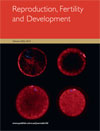Reproduction, Fertility and Development
Volume 24
Number 5 2012
Oxytocin and vasopressin are present in the yolk sac of the equine pre-attachment embryo. They are supposable candidates for the regulation of equine embryo expansion mediated by aquaporins and ATPases abundant in the trophoblast. Expression of oxytocin, vasopressin 1A and 2 receptors could be proven by means of RT-PCR and immunohistochemistry in equine embryos between Days 10 and 16, making involvement of these two hormones very probable for embryo expansion.
Until now the only possible treatment for varicocele, the most common cause of primary male infertility, has been surgery. In the present study, anthocyanin improved sperm motility, spermatogenic cell density and testis weight. These actions are likely due to anthocyanin-induced reductions in oxidative damage resulting from varicocele-induced venous stasis. The results of the present study may be the initial step in developing a medical approach for the treatment of varicocele.
This is the first report showing the existence and interaction of kisspeptin and its receptors in porcine cumulus–oocyte complexes and its enhancing role in oocyte maturation and subsequent embryo developmental competence in an autocrine–paracrine manner. However, Kp supplementation may have a paradoxical impact on hatched blastocyst development reflecting systemic or local regulation during this early critical period.
The fatty acid composition of supplemented fat in the diet has a role in improving reproductive efficiency. The study was carried out to elucidate the effect of different sources of dietary energy (maize vs polyunsaturated fatty acid (PUFA)-rich sunflower oil) on sperm quality in rams and the result suggested that dietary PUFA protected sperm membrane integrity. Developing a dietary regimen that includes PUFA might improve the fertility potential of bulls.
Oocyte maturation is critical to its developmental potential and is characterized by changes in the distribution and activity of mitochondria in the oocyte. We investigated the effect of two fat energy sources, linoleic acid (LA; omega-6) and alpha-linolenic acid (ALA; omega-3), on bovine oocyte maturation and showed negative effects of LA and positive effects of ALA on the mitochondria profile. High LA levels in diets may be detrimental for oocyte development and result in reduced fertility.
A basic understanding of the molecular pathways that regulate developmental events during early feline embryogenesis is still lacking. The aim of the study was to quantify mRNA profiles of pluripotency and differentiation-related markers during preimplantation development and results showed that these genes are expressed and undergo species-specific changes during early embryonic development. These findings add evidence to the hypothesis that behavior of these markers may differ among species.
Mammary gland development during pregnancy is a tightly regulated process necessary for lactation, and strongly dependent on hormonal control. This report aimed to investigate whether the same hormonal changes that lead to parturition in rats were responsible for triggering mammary gland maturation required for the initiation of milk production. Our study provides clear in vivo evidence of the role of progesterone as a key hormonal player for both mammary development and milk production, and demonstrates that lactogenesis may be advanced as long as the action of progesterone is abolished.
Embryo survival is a major factor affecting reproductive success with both systemic progesterone and retinol demonstrating significant effects on embryo development. Our aim was to determine the effects of systemic progesterone on the uterine expression of retinol’s transportation protein, RBP4, in cyclic dairy cattle. RBP4 expression in the bovine uterus was altered by progesterone in a time- and concentration-dependant manner and therefore may play a role in regulating embryo development in cattle.
This study brings new information on bone morphogenetic proteins (BMPs) that can contribute to the understanding of ovarian folliculogenesis. The levels of mRNA for BMP system in goat preantral follicles before and after culture for 18 days were evaluated. Increased levels of mRNA for BMP-2 and reduced mRNA for BMP-4, BMP-7, BMPR-IA and SMAD-5 were observed in cultured follicles. These data are essential for improvement of in vitro development of good-quality oocytes.
Undernutrition as a result of dietary restriction can contribute to female infertility. In this study, we examine the effects of undernutrition on oocyte development and demonstrate that this process is dependent on GLUT1 expression and glucose uptake in cumulus-oocyte complexes. These results demonstrate the importance of proper nutrition and glucose metabolism in female fertility and implicate GLUT1 in this process.
This study assessed the effects of follicle fluid on fertilisation ability of bovine oocytes. Supplementation of culture medium with follicle fluid during in vitro maturation of oocytes promoted sperm penetration during in vitro fertilisation both by improving cumulus expansion and by enhancing ATP levels in oocytes, which maintained their ability to be fertilised even after mitochondrial stress. This finding may be useful for further development of maturation media especially when oocytes are marked out for mitochondria-damaging treatments.
Antenatal glucocorticoids are administered to pregnant women in preterm labour and enhance survival of preterm infants by maturing the lungs prior to birth. However, these synthetic glucocorticoids may reduce normal patterns of fetal growth, with this study showing that this is significantly pronounced in female fetuses. These data suggest that the fetus and/or placenta of male and female fetuses may differentially regulate the response to maternal glucocorticoids.
Previous studies indicate that the genes that control circadian rhythmicity also have a role in parturition. A transgenic mouse was generated in which the rhythmicity-associated gene Bmal1 is deleted in the myometrium; females of this transgenic line were less likely to labour at the expected time of day than control mice. This report introduces a new transgenic mouse model and suggests an important role for myometrium-specific expression of Bmal1 in parturition timing.




